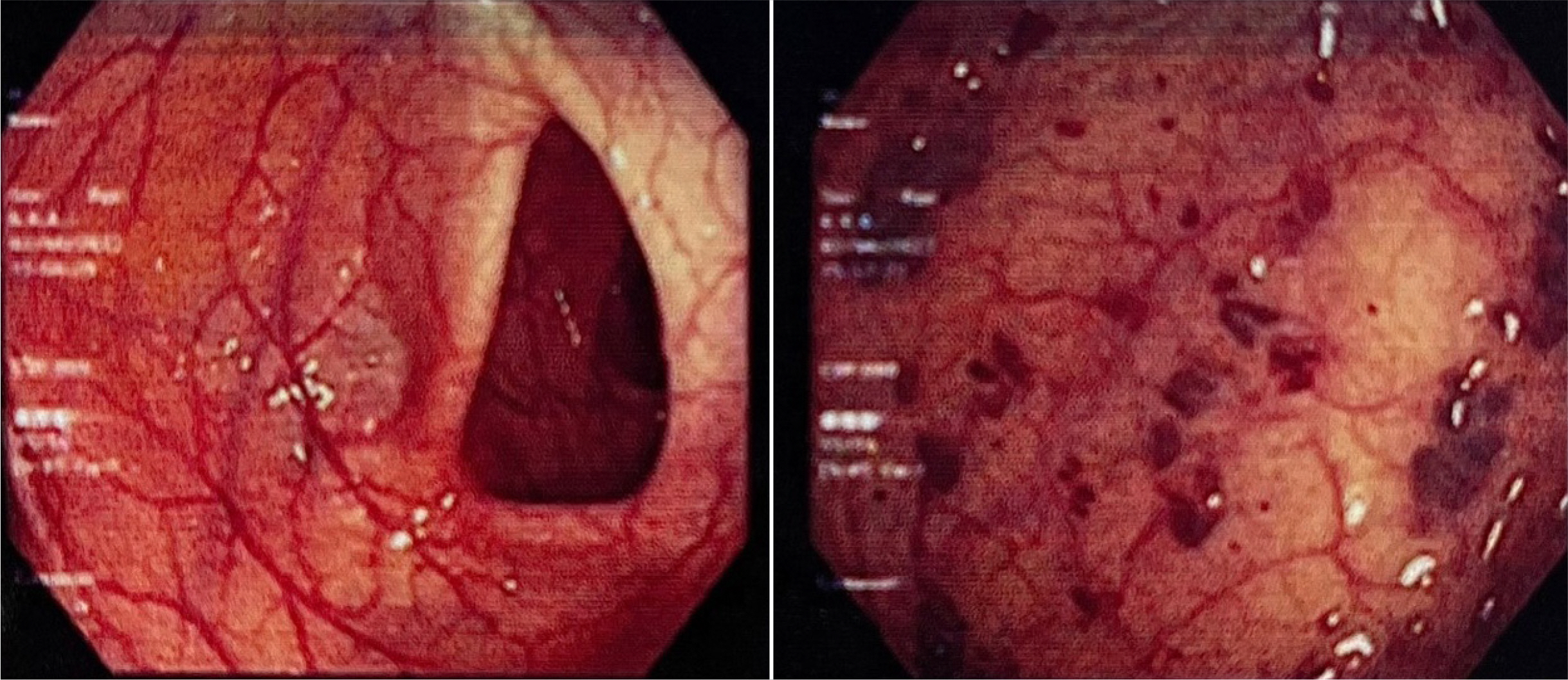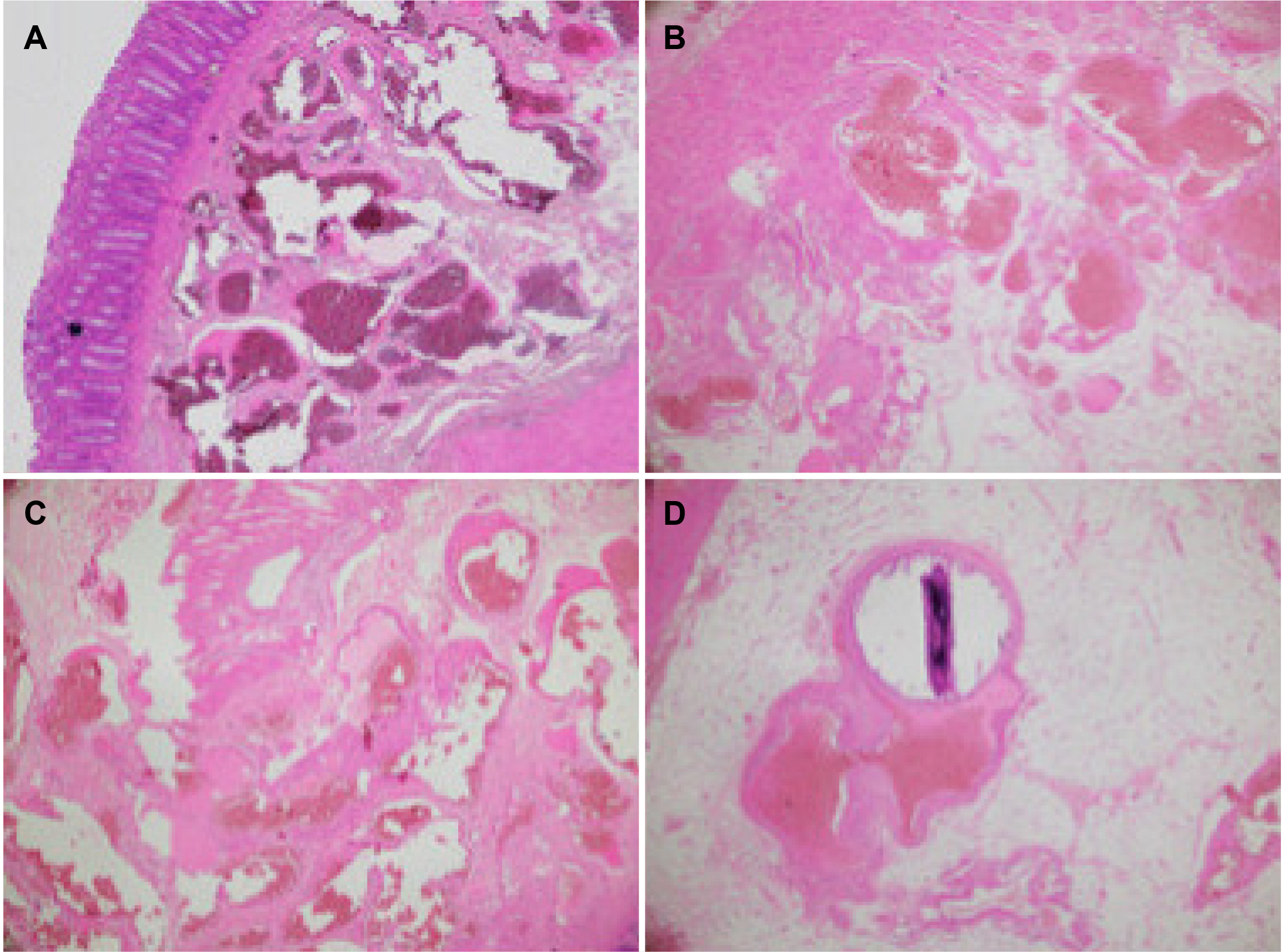Korean J Gastroenterol.
2023 May;81(5):216-220. 10.4166/kjg.2023.013.
Colorectal Arteriovenous Malformations causing Prolonged Bleeding were Managed Successfully by Laparoscopic Low Anterior Resection with Sphincter Preservation: A Case Report
- Affiliations
-
- 1Department of Colon and Rectal Surgery, Institute of Digestive Surgery, 108 Military Central Hospital, Hanoi, Vietnam
- 2College of Health Sciences, VinUniversity, Hanoi, Vietnam
- KMID: 2542788
- DOI: http://doi.org/10.4166/kjg.2023.013
Abstract
- Gastrointestinal arteriovenous malformations (AVMs) are a rare disease. Sigmoid-anorectal AVM has only been reported in a few cases. The condition is usually detected when patients have gastrointestinal bleeding complications. The diagnosis and treatment of colorectal AVMs are still challenging. This paper presents a case of an Asian 32-year-old female patient admitted to hospital because of lower gastrointestinal bleeding lasting 17 years. The patient was diagnosed with sigmoid-rectal arteriovenous malformation and failed with other medical treatments. The damaged gastrointestinal tract was removed by a laparoscopic low anterior resection. The results were positive after a three-month follow-up; the bleeding was resolved, and the anal sphincter function was intact. Laparoscopic low anterior resection is a safe, less invasive, and effective approach for managing patients with digestive tract bleeding due to extensive colorectal AVM and preservation of the anal sphincter.
Keyword
Figure
Reference
-
1. Margulis AR, Heinbecker P, Bernard HR. 1960; Operative mesenteric arteriography in the search for the site of bleeding in unexplained gastrointestinal hemorrhage: a preliminary report. Surgery. 48:534–539.2. Richter JM, Hedberg SE, Athanasoulis CA, Schapiro RH. 1984; Angiodysplasia. Clinical presentation and colonoscopic diagnosis. Dig Dis Sci. 29:481–485. DOI: 10.1007/BF01296266. PMID: 6609803.3. Yano T, Yamamoto H, Sunada K, et al. 2008; Endoscopic classification of vascular lesions of the small intestine (with videos). Gastrointest Endosc. 67:169–172. DOI: 10.1016/j.gie.2007.08.005. PMID: 18155439.
Article4. Mindelzun RE, Beaulieu CF. 1997; Using biphasic CT to reveal gastrointestinal arteriovenous malformations. AJR Am J Roentgenol. 168:437–438. DOI: 10.2214/ajr.168.2.9016222. PMID: 9016222.
Article5. Townsend CM, Beauchamp RD, Evers BM, Mattox KL, Sabiston DC. 2021. Sabiston textbook of surgery: the biological basis of modern surgical practice. Elsevier;St. Louis, MO: 21st ed.6. Foutch PG, Rex DK, Lieberman DA. 1995; Prevalence and natural history of colonic angiodysplasia among healthy asymptomatic people. Am J Gastroenterol. 90:564–567.7. McAllister KA, Grogg KM, Johnson DW, et al. 1994; Endoglin, a TGF-beta binding protein of endothelial cells, is the gene for hereditary haemorrhagic telangiectasia type 1. Nat Genet. 8:345–351. DOI: 10.1038/ng1294-345. PMID: 7894484.
Article8. Boley SJ, DiBiase A, Brandt LJ, Sammartano RJ. 1979; Lower intestinal bleeding in the elderly. Am J Surg. 137:57–64. DOI: 10.1016/0002-9610(79)90011-4. PMID: 310250.
Article9. Gordon FH, Watkinson A, Hodgson H. 2001; Vascular malformations of the gastrointestinal tract. Best Pract Res Clin Gastroenterol. 15:41–58. DOI: 10.1053/bega.2000.0155. PMID: 11355900.
Article10. Junquera F, Quiroga S, Saperas E, et al. 2000; Accuracy of helical computed tomographic angiography for the diagnosis of colonic angiodysplasia. Gastroenterology. 119:293–299. DOI: 10.1053/gast.2000.9346. PMID: 10930363.
Article11. Su CC, Yang TW, Tsai MC. 2021; A rare cause of gastrointestinal bleeding: Duodenal arteriovenous malformation. Advances in Digestive Medicine. 8:55–58. DOI: 10.1002/aid2.13198.
Article12. Farrell JJ, Friedman LS. 2005; Review article: the management of lower gastrointestinal bleeding. Aliment Pharmacol Ther. 21:1281–1298. DOI: 10.1111/j.1365-2036.2005.02485.x. PMID: 15932359.
Article13. Bua-Ngam C, Norasetsingh J, Treesit T, et al. 2017; Efficacy of emergency transarterial embolization in acute lower gastrointestinal bleeding: A single-center experience. Diagn Interv Imaging. 98:499–505. DOI: 10.1016/j.diii.2017.02.005. PMID: 28341118.
Article14. Defreyne L, Meersschaut V, van Damme S, Berrevoet F, Robberecht E, Praet M. 2003; Colonic arteriovenous malformation in a child misinterpreted as an idiopathic colonic varicosis on angiography: remarks on current classification of childhood intestinal vascular malformations. Eur Radiol. 13 Suppl 4:L138–L141. DOI: 10.1007/s00330-003-1967-8. PMID: 15018179.
Article15. Hellstrom J, Hultborn KA, Engstedt L. 1955; Diffuse cavernous hemangioma of the rectum. Acta Chir Scand. 109:277–283.16. Wang CH. 1985; Sphincter-saving procedure for treatment of diffuse cavernous hemangioma of the rectum and sigmoid colon. Dis Colon Rectum. 28:604–607. DOI: 10.1007/BF02554157. PMID: 4017824.
Article
- Full Text Links
- Actions
-
Cited
- CITED
-
- Close
- Share
- Similar articles
-
- Laparoscopic Low Anterior Resection in a Rectal Cancer Patient with Situs Inversus Totalis: A Case Report
- Efficacy and Safety of Endoscopic Clipping for Acute Anastomotic Bleeding After Colorectal Surgery
- Arteriovenous malformation of the uterus-a cause of massive operative bleeding
- Re-anastomosis above a Preceding Anastomosis Made by a Low Anterior Resection
- Surgery of Parasplenial Arteriovenous Malformation with Preservation of Vision : A Case Report





